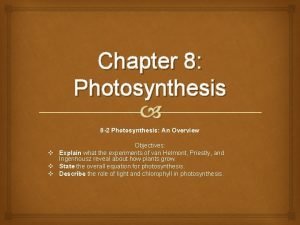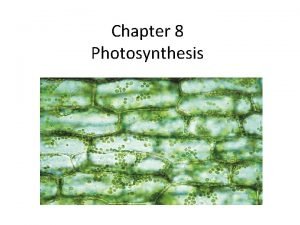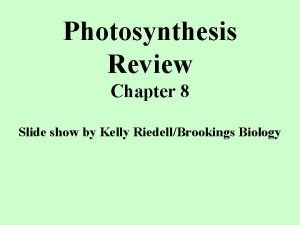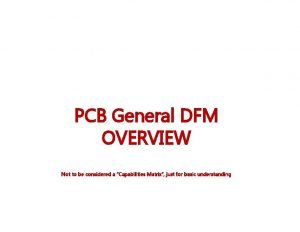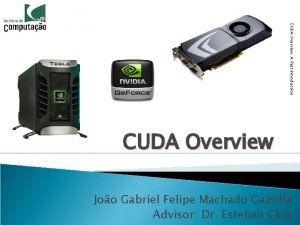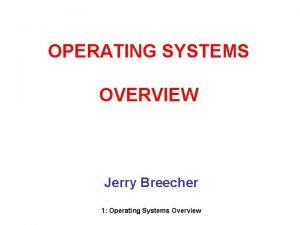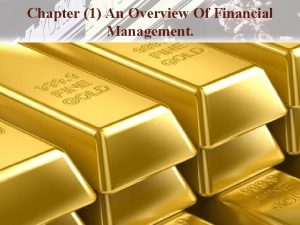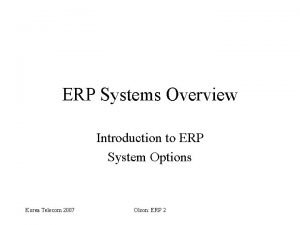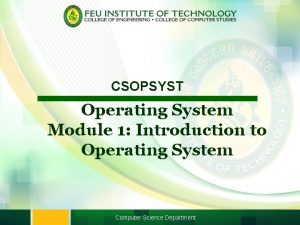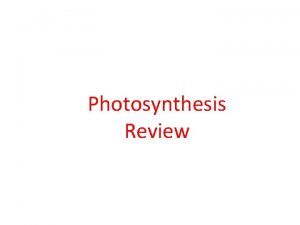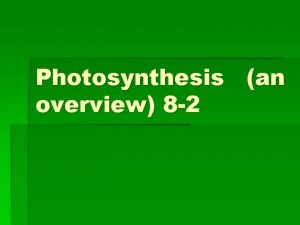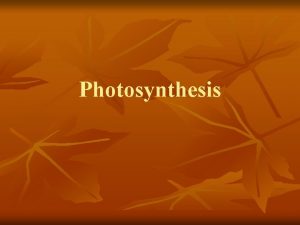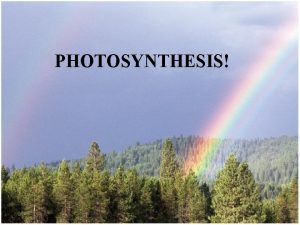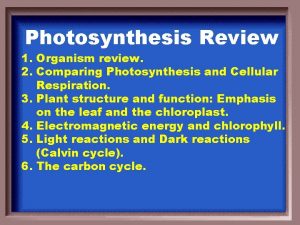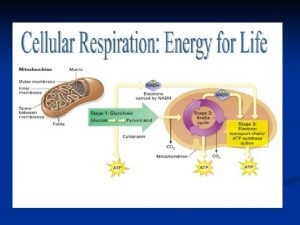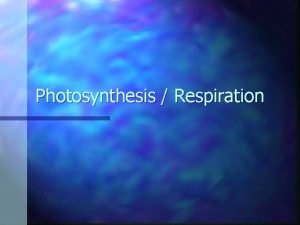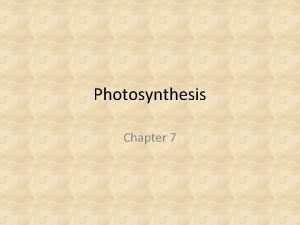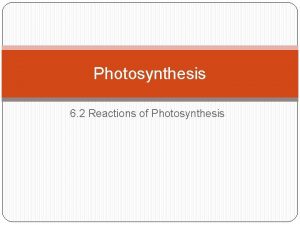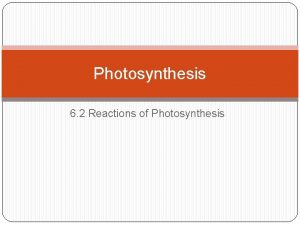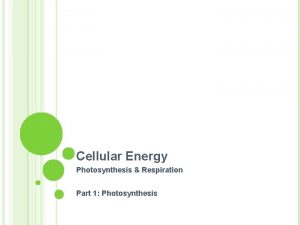Photosynthesis Review Photosynthesis An Overview Photosynthesis is the

































































- Slides: 65

Photosynthesis Review

Photosynthesis: An Overview § Photosynthesis is the process by which some organisms convert the energy in sunlight into the energy stored in sugar (and other organic molecules)

Photosynthesis § Autotrophs and Heterotrophs – Autotroph = “self-feeder” § § § Also known as producers Able to produce their own food Plants, algae, some bacteria – Heterotroph = “other-feeder” § § § Also known as consumers Cannot produce their own food Fungi, animals, some bacteria

Chloroplast & Leaf Structure § Most photosynthesis occurs in the leaves of plants – Palisade & Spongy Mesophyll – Gases (O 2 and CO 2) enter and exit the leaves through stomata (tiny pores in leaf surface) § Chloroplasts – The site of photosynthesis in plant cells – Thylakoids – individual discshaped sac – Granum (plural – grana) – a stack of thylakoids – Stroma – fluid within the chloroplast

Photosynthesis § The Big Picture: – The process by which plants convert light energy into chemical energy – Overall equation: § 6 CO 2 + 6 H 2 O + light energy C 6 H 12 O 6 + O 2 Redox Reaction: Water is oxidized (loses electrons) and CO 2 is reduced (gains electrons) – 2 Stages: § The Light Reactions (requires light) § The Calvin Cycle (does not require light)

Overview of Photosynthesis

Light and the Electromagnetic Spectrum § Wavelength = – distance between two identical places on a wave § Photons = – discrete particles of light – Not all have the same amount of energy § As wavelength gets longer, energy gets lower § Which color of visible light has the most energy?

The Light Reactions § First Phase § Occur in the thylakoids of the chloroplast (plants & autotrophic protists) § Occurs on cell membranes of bacteria § Overall Function: – Conversion of light energy (sunlight) into chemical energy (NADPH and ATP) to drive the Calvin Cycle

Photosynthetic Pigments § Pigments = – substances that absorb visible light – Each have different absorption spectra § 3 main pigments involved in photosynthesis: – Chlorophyll a – Chlorophyll b – accessory pigment – Carotenoids – accessory pigment § Each pigment absorbs light energy at its own specific wavelength. By having several pigments, plants can more efficiently absorb more wavelengths of light.

Photosystems § Photosystems are made up of pigments (to absorb light) bound to proteins § There are 2 photosystems: – Photosystem I - P 700 § absorbs light best at wavelength of 700 nm (Red light) – Photosystem II - P 680 § absorbs light best at wavelength of 680 nm (Red light) § Named in order of their discovery

Photosystems § Photosystems: – Chlorophyll is organized along with other molecules into photosystems – “Antenna complex” § Made up of several hundred pigment molecules § Gathers light Two photosystems have more reducing power than one!

Photosystems § Reaction Center: – Made up of a certain chlorophyll a molecule and the primary electron acceptor § Once a photon strikes the photosystem, an electron is “excited” to a higher energy level § Energy is passed from one pigment molecule to another until it gets to this particular chlorophyll a molecule § Primary Electron Acceptor “steals” the electron from chlorophyll a

Noncyclic Electron Flow 1. Photosystem II absorbs light, and therefore loses an electron to the PEA. - PSII is now one electron short of what it needs 2. This electron is replaced by the splitting of water. –O 2 is released as a byproduct.


Noncyclic Electron Flow 3. Excited electron leaves PEA and goes to Photosystem I, travelling via an electron transport chain. - -The electron “loses” energy as it travels down the ETC. This ETC harnesses the energy from the electron to produce ATP by chemiosmosis. 4. When the electron gets down to the bottom of the ETC, it replaces an electron that has been lost from Photosystem I because of photoexcitation.

Noncyclic Electron Flow 5. The PEA of PS I passes the excited electron to ferredoxin - (part of ETC #2) 6. The enzyme NADP+ reductase transfers the electrons from ferredoxin to NADP+. - NADPH is produced (electron carrier)

The Light Reactions

Chemiosmosis in Chloroplasts § ATP is generated using the process of chemiosmosis § Protons (H+) are pumped from stroma into thylakoid space – Pumping energy comes from energy lost by electrons – Charge difference on each side of the membrane creates an electrochemical gradient. – Potential energy

Chemiosmosis § As protons diffuse through ATP synthase (enzyme) in the thylakoid membrane, the potential energy (in H+ concentration) is used to form a bond between ADP + a phosphate group – ATP is formed

Chemiosmosis

The Calvin Cycle § Second Phase: § Occurs in the stroma of the chloroplast § Big Picture: – Uses CO 2 (from atmosphere) and energy (from the Light Reactions) to make SUGAR

The Calvin Cycle § Carbon Fixation: – The incorporation of inorganic CO 2 into organic material. – Larger organic molecules store more energy!

Phase I: Carbon Fixation § 5 -carbon Ru. BP is attached to 1 CO 2 molecule to produce 1 6 -carbon molecule – This reaction is catalyzed by Rubisco (a. k. a. Ru. BP Carboxylase) § Unstable 6 -carbon molecule splits into (2) 3 -carbon molecules – 3 -phosphoglycerate (PGA)

Phase II: Reduction § Each 3 -phosphoglycerate gets a phosphate added to it from ATP (light reactions) § NADPH donates electrons to convert 3 phosphoglycerate to G 3 P (a. k. a. as PGAL) – G 3 P is a carbohydrate/ stores more energy than 3 phosphoglycerate

Phase II: Reduction § Now… – For every 3 molecules of CO 2 that entered the cycle, we have 6 molecules of G 3 P § However… – Only 1 is a netgain & is converted to glucose

Phase III: Regeneration of Ru. BP § 5 G 3 P molecules (3 -C each) are rearranged into 3 Ru. BP molecules (5 -C each) to complete the cycle § This conversion requires 3 ATP

An Overview: Light Reactions & the Calvin Cycle § Light Reactions: – Provide the energy (ATP and NADPH) required to run the Calvin Cycle § Calvin Cycle: – Uses the energy (ATP and NADPH) from the light reactions and carbon dioxide (from the atmosphere) to make carbohydrates

Photorespiration & Alternative Methods of Carbon Fixation

Photorespiration § Stomata are pores in the leaf surface, through which: – Carbon dioxide enters the plant – Water evaporates from the plant – Oxygen leaves the plant

C 3 Plants & Photorespiration § In hot, dry climates, C 3 plants close their stomata. (Most plants, such as rice, wheat, & soybeans are C 3 plants. ) – Pro: § plant doesn’t lose as much water – Cons: § Plant doesn’t receive carbon dioxide § Plant can’t get rid of oxygen § Photorespiration, a WASTEFUL process occurs.

C 3 Pathway § Uses only the Calvin Cycle § Called C 3 because PGA is a 3 -C compound § Occurs in mesophyll cells

Photorespiration § With stomata closed, O 2 levels become higher than CO 2 levels in the mesophyll. § Rubisco (Ru. BP carboxylase) joins O 2 to Ru. BP, instead of the usual CO 2. § When O 2 is joined to Ru. BP, photorespiration occurs. – No glucose or ATP is produced, so O 2 is WASTED!

Alternative Methods of Carbon Fixation C 4 & CAM plants have developed ways to minimize photorespiration & optimize the Calvin Cycle

C 4 Pathway § Different location within the leaf § Carbon is fixed into a 4 C compound using PEPCarboxylase, not Rubisco § The compound (malate) is pumped into bundle sheath cells, where CO 2 is released & enters Calvin Cycle. § This increases the concentration of CO 2

C 4 Pathway, cont’d § Since the concentration of CO 2 is greater than the concentration of O 2, the Calvin Cycle is favored over photorespiration § Especially useful in hot, dry climates! § Examples: – Corn – Sugar cane – Sorghum

C 3 vs. C 4 § Different LOCATIONS within the leaf

CAM pathway § Occurs at a different time § Open stomata at NIGHT to store CO 2 for use during the day. § Like C 4 plants, PEPcarboxylase is used to fix carbon to form a 4 C compound for storage. – Pros: § Prevents water loss § Prevents CO 2 from leaving the leaves – Con: § Plant grows slowly

CAM Plants, cont’d… § CO 2 is stored overnight until the light reactions can supply ATP and NADPH to drive the Calvin Cycle § Examples: – – – Cacti Pineapples Succulents (adaptations for hottest, most arid climates)

Lab 4: Chromatography and the Rate of Photosynthesis Separating Pigments & Determining Photosynthetic RATE

Rate = Δ “something measured” time § This lab has 2 parts – separating pigments physically with a technique called chromatography – calculating the RATE of photosynthesis by reducing an indicator, DPIP, and measuring the transmittance of a sample of chloroplasts that you have incubated in light for set time INTERVALS

Absorption of Light § Light travels as a wave. § The electromagnetic spectrum contains MANY different types of “light”. § Visible light is a very small slice of the electromagnetic spectrum. § As white light is passed through a prism, it is refracted and we can see ROYGBIV.

What do you mean, really not green? § A leaf is not really green. For that matter, any color you see is not really that color! § It is actually every other color BUT the color you perceive. WHY? ? § Pigments absorb light of various wavelengths, λ, and reflect others. § These reflections are what we “see”. § If you see green, it’s because that is NOT absorbed, but rather reflected.

Electromagnetic Spectrum

Absorption Spectra § When a pigment is exposed to white light, it absorbs some of the light and reflects others. § What is absorbed can be graphed and the highest absorption corresponds to a peak on the graph. § Chlorophylls a & b each have 2 peaks in the red and blue range











Now for the photosynthesis part! § Let’s shift gears and get a quick overview of the photosynthesis. § Chloroplasts will be extracted from spinach. § NADPH will be replaced with DPIP and the reduction reactions taking place, due to the light reaction, will turn DPIP from blue to colorless § A spectrophotometer will be used to measure the “transmittance” of light at a set time interval. § As the solution becomes more clear, more light will be transmitted so expect direct relationships when you graph the data!


I love that statement! I “mechanically disrupt” the membrane with a BLENDER!








 Chapter 9 lesson 2 photosynthesis an overview
Chapter 9 lesson 2 photosynthesis an overview Chapter 8 section 2 photosynthesis answer key
Chapter 8 section 2 photosynthesis answer key Atp and adp cycle
Atp and adp cycle Products of photosynthesis
Products of photosynthesis Hình ảnh bộ gõ cơ thể búng tay
Hình ảnh bộ gõ cơ thể búng tay Cái miệng xinh xinh thế chỉ nói điều hay thôi
Cái miệng xinh xinh thế chỉ nói điều hay thôi Cách giải mật thư tọa độ
Cách giải mật thư tọa độ Từ ngữ thể hiện lòng nhân hậu
Từ ngữ thể hiện lòng nhân hậu Tư thế ngồi viết
Tư thế ngồi viết Thứ tự các dấu thăng giáng ở hóa biểu
Thứ tự các dấu thăng giáng ở hóa biểu Chó sói
Chó sói Thẻ vin
Thẻ vin Thể thơ truyền thống
Thể thơ truyền thống Sự nuôi và dạy con của hươu
Sự nuôi và dạy con của hươu Thế nào là hệ số cao nhất
Thế nào là hệ số cao nhất Diễn thế sinh thái là
Diễn thế sinh thái là Vẽ hình chiếu vuông góc của vật thể sau
Vẽ hình chiếu vuông góc của vật thể sau Frameset trong html5
Frameset trong html5 101012 bằng
101012 bằng Lời thề hippocrates
Lời thề hippocrates Vẽ hình chiếu đứng bằng cạnh của vật thể
Vẽ hình chiếu đứng bằng cạnh của vật thể Tư thế worm breton
Tư thế worm breton đại từ thay thế
đại từ thay thế Quá trình desamine hóa có thể tạo ra
Quá trình desamine hóa có thể tạo ra Khi nào hổ mẹ dạy hổ con săn mồi
Khi nào hổ mẹ dạy hổ con săn mồi Thế nào là mạng điện lắp đặt kiểu nổi
Thế nào là mạng điện lắp đặt kiểu nổi Các châu lục và đại dương trên thế giới
Các châu lục và đại dương trên thế giới Dot
Dot Biện pháp chống mỏi cơ
Biện pháp chống mỏi cơ Bổ thể
Bổ thể độ dài liên kết
độ dài liên kết Thiếu nhi thế giới liên hoan
Thiếu nhi thế giới liên hoan Chúa yêu trần thế alleluia
Chúa yêu trần thế alleluia điện thế nghỉ
điện thế nghỉ Fecboak
Fecboak Một số thể thơ truyền thống
Một số thể thơ truyền thống Trời xanh đây là của chúng ta thể thơ
Trời xanh đây là của chúng ta thể thơ Sơ đồ cơ thể người
Sơ đồ cơ thể người Công thức tính độ biến thiên đông lượng
Công thức tính độ biến thiên đông lượng Số nguyên tố là
Số nguyên tố là đặc điểm cơ thể của người tối cổ
đặc điểm cơ thể của người tối cổ Tỉ lệ cơ thể trẻ em
Tỉ lệ cơ thể trẻ em Các châu lục và đại dương trên thế giới
Các châu lục và đại dương trên thế giới ưu thế lai là gì
ưu thế lai là gì Môn thể thao bắt đầu bằng chữ đua
Môn thể thao bắt đầu bằng chữ đua Tư thế ngồi viết
Tư thế ngồi viết Ap gov final review
Ap gov final review Narrative review vs systematic review
Narrative review vs systematic review Search strategy example
Search strategy example Chapter review motion part a vocabulary review answer key
Chapter review motion part a vocabulary review answer key Narrative review vs systematic review
Narrative review vs systematic review Copper thieving pcb
Copper thieving pcb Cuda overview
Cuda overview Psrcour
Psrcour Operating systems overview
Operating systems overview Market overview managed file transfer solutions
Market overview managed file transfer solutions Overview of financial management
Overview of financial management Fsma overview
Fsma overview Erp system introduction
Erp system introduction Atm wan technology
Atm wan technology Dual mode in os
Dual mode in os Small pictures that represent files folders and programs
Small pictures that represent files folders and programs In uml is a connection among things
In uml is a connection among things Overview of grid computing
Overview of grid computing M commerce infrastructure
M commerce infrastructure Sdn introduction
Sdn introduction

